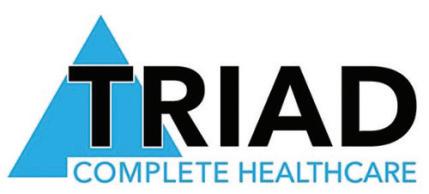






Early detection is your best defense against breast cancer,and that’swhy scheduling your annual mammogram is so important.

Schedule your appointment todayatthe Saint Francis Hospital
Muskogee Breast Center located at 101South Rockefeller Drive, Suite101.Weoffer advanced 3D digital mammographyand ultrasound services so youcan getthe screenings youneed, closer to home.
Saint Francis Hospital Muskogee BreastCenter
Xavier Building
101S.Rockefeller Dr., Suite101 Muskogee, Oklahoma 74401 918-494-6900
To learn more, visit saintfrancis.com/breastservices or call 918-494-6900. Appointments can also be scheduled online through your Saint Francis MyChartaccount.
101South Rockefeller Drive, Suite101
Muskogee, Oklahoma
saintfrancis.com/breastservices








GCBHS continues to meet thehighest levelofHealthyBusinessCertification


We offer outpatientcounseling, evaluations, andtreatment formentalhealthand substance useconcerns.Weare also developing services forthe aging. We have 24-hourmobilecrisis response forall ages, andUrgent Recover yCareand Crisis Stabilization services foradults, regardlessofincome. Ournew mobileunit, the GCBHS Care-A-Van,travels over Muskogee County allowing staff to takeour services to remote ruralareas





GCBHS is aproud partnerofthe OklahomaDepartmentofMentalHealth& SubstanceAbuse Services. ODMHSASpartially funds GCBHS andhas certified ourprograms “WithDistinction.” We areaNARCAN hub! Just call us!!



IF YOUARE EXPERIENCINGA MENTAL HEALTH OR SUBSTANCE CRISIS, PLEASE CALL 9-8-8. ATRAINED PROFESSIONALWILL ANSWER.WEHAVE24/7/365 MOBILE RESPONSESERVICES!




Discover the untapped benefits of regular well visits: early detection, personalized care, and a path to overall wellness.
Exercises, relaxation techniques can alleviate strain, reduce fatigue and improve vision in our digital age.


12
Emotional and physical connection can transform your relationships, boost well-being, and ignite lasting happiness.
14
Beginners, ultra runners and walkers unite to pursue their passion for the sport.

18 Minimize toxins
Recognize silent household toxins that impact your health without your knowledge.
20 Acupuncture
Treatment is embraced worldwide, with potential benefits for back pain, osteoarthritis, headaches, and more.
Regular screenings, lifestyle modifications and medical interventions can help slow down the progression of CKD.
Unlock the secrets in genes, empowering you to make informed decisions.

PHOTO: Health care providers can discuss healthy lifestyle choices such as exercise, nutrition, stress management and mental health.
While many people seek medical attention only when they are unwell, the significance of routine check-ups cannot be overstated. These preventive appointments, often referred to as well visits or physicals, offer a range of benefits that extend beyond immediate health concerns.
Harvard Medical School recommends having one of these visits at least annually. Most insurance policies cover them and Medicare makes them available at no cost.
One of the primary reasons well visits are crucial is their role in early detection and prevention of illnesses. During these appointments, health care professionals conduct comprehensive assessments of your overall health, including physical examinations, medical assessments of your overall health, medical history reviews and routine screenings.
By monitoring key health indicators and identifying potential risk factors, doctors can detect health issues at their nascent stages. Early detection allows for timely intervention and treatment, which can significantly improve outcomes and even save lives.
Well visits also offer an opportunity to receive vaccinations and immunizations, protecting you from preventable diseases and reducing the risk of outbreaks within communities.
During well visits, you can discuss age-appropriate screenings such as colorectal cancer screens, mammograms and prostrate screenings.
Regular well visits foster an ongoing relationship between you and your health care provider. Continuity of care is vital as it enables doctors to better understand your unique health needs, lifestyle and medical history. By developing this rapport, you can receive personalized health care recommendations tailored to your specific circumstances.
Open communication with your health care provider during well visits allows for the discussion of any concerns, questions or changes in your health status. This interaction empowers you to take an active role in your own health and make informed decisions about your well-being.

An ongoing relationship lets your health care provider track important health statistics related to cholesterol, weight, blood pressure and blood sugar before they become issues.
Well visits extend beyond the prevention and treatment of illnesses. They also focus on promoting overall wellness. Health care providers often use these visits as an opportunity to discuss healthy lifestyle choices such as exercise, nutrition, stress management and mental health.
They can provide guidance on disease prevention, smoking cessation, weight management and more. By addressing these aspects, well visits empower individuals to adopt healthier habits and make positive changes that enhance their quality of life.
For individuals living with chronic conditions, well visits play an important role in managing their health. Regular monitoring and check-ups enable health care providers to assess the progression of the condition, adjust treatment plans and provide necessary support and education.
Health care providers can help individuals maintain optimal health and prevent further complications by addressing the concerns as they emerge. Well visits become an essential part of managing chronic conditions, fostering well-being and improving the overall quality of life for those affected.

In our modern digital age, our eyes are subjected to increased strain and fatigue due to excessive screen time and other visually demanding activities. To counteract these effects and promote optimal eye health, incorporating eye exercises and relaxation
techniques into our daily routines can be highly beneficial. According to the National Center for Health Research, most Americans spend five hours or more each day looking at digital devices, defined as anything with an LED screen.
People who spend extended periods reading, using digital devices or focusing on close-up tasks commonly experience eye strain and fatigue. Symptoms
include dryness, blurred vision, headaches, neck and back ache and eye discomfort. The Vision Council says almost two out of three Americans report experiencing symptoms of eye strain.
Prolonged strain can lead to long-term vision problems. Research shows that it reduces productivity and increases the amount of errors people make.
Eye exercises and relaxation techniques offer a proactive approach to combating these issues, improving blood circulation, relieving tension and rejuvenating the eyes.

It’s not just your body that needs exercise and relaxation techniques—so do our eyes.















Eye exercises strengthen eye muscles, enhance flexibility and improve eye coordination. Regular practice can help alleviate eye strain, reduce fatigue and potentially improve vision. By stimulating blood flow to the eyes, these exercises contribute to better nutrient delivery and waste removal from ocular tissues, promoting overall eye health. They can help

combat dry eyes and enhance focus, making them valuable for those who spend significant time in front of screens or performing visually demanding tasks.
In addition to exercises, incorporating relaxation techniques into your eye care routine can provide relief and promote overall eye health. These techniques aim to reduce stress and tension in the eyes and surrounding muscles.
The Kraff Eye Institute recommends these eye exercises and relaxation techniques:
• Palming: Rub your hands together to warm them up. Close your eyes, place the palm of each hand over your cheekbone. Cup your hand over each eye and breathe deeply for five minutes.
• Blinking: Close your eyes for two seconds and then open them again. Repeat several times.
• Pencil Pushups: Hold a pencil at arm’s length and focus on the eraser. Slowly move it to your nose, keeping the eraser in focus. When it goes double, draw it away from the eyes. Repeat several times.
• Near and Far Focus: Hold your thumb about a foot away from your face and focus on it for 15 seconds. Then move your eyes to focus on something that is

20 feet away and stare at it for 15 seconds. Return to your thumb. Repeat several times.
• 20-20-20 Rule: For every 20 minutes of near work, look at a target 20 feet away for 20 seconds.
• Figure Eight: Pick a point 10 feet away from you. Trace an imaginary figure 8 with your eyes for 30 seconds and then reverse directions.
Incorporating these into your daily routine can alleviate some of the strain caused by modern lifestyles. Dedicating a few minutes each day to these practices can rejuvenate your eyes, improve focus, reduce eye fatigue and promote overall well-being. Consult with an eye care professional for guidance and to address any underlying eye conditions.
In a world where connections can feel fleeting and superficial, healthy intimacy can be a pillar of lasting happiness and well-being. Beyond the whispers of physical desire, healthy intimacy is the invisible thread that weaves through the fabric of our relationships, nurturing our emotional bonds and overall health.

Healthy intimacy goes beyond physical intimacy to encompass emotional connection, trust and open communication. New York State’s web site defines healthy relationships as incorporating trust, honesty, respect and open communication. There is a balance of power and partners respect each other’s independence.
Characteristics of healthy relationships include a respect for privacy and space. They include good boundaries, strong and open communication, respect, trust and consent. Consent can be given and removed at any time.
Emotional intimacy involves sharing feelings, thoughts and vulnerabilities with a partner. Effective communication is the foundation of emotional intimacy. Cultivate empathy by putting yourself in your partner’s shoes and striving to understand their perspective. Validate their feelings.

Dedicate quality time to connect with your partner on a deeper level and put away all distractions. Engage in activities you both enjoy. Openly discuss your dreams, aspirations and goals with your partner. Express your love, appreciation and affection for your partner through words and actions. Small gestures of
kindness, hugs, kisses and heartfelt compliments can nurture emotional intimacy.
Practice active listening by giving your full attention, maintaining eye contact and responding with empathy. Share your fears, insecurities and past experiences and allow your partner to do the same. Resolve conflict with respect and compassion. Seek resolution through respectful and compassionate communication.
In an environment of consent, respect and communication, physical intimacy can promote emotional connection, reduce stress and enhance overall well-being. Such actions as hugging, cuddling or intimate touch releases oxytocin, sometimes referred to as the “bonding hormone.” It promotes feelings of trust, attachment and emotional closeness.
Intimate touch and sexual activity triggers the release of endorphins, which are natural mood boosters and stress relievers. The sensations experienced during physical intimacy can promote relaxation, ease muscle tension and provide a temporary escape from daily stressors.
Physical intimacy fosters a sense of happiness, contentment and fulfillment. It promotes a sense of belonging and emotional security within a relationship. Regular physical intimacy can lead to improved self-esteem, increased feelings of attractiveness and a greater sense of emotional connection to your partner.
The process of exploring desires, boundaries and preferences encourages partners to communicate openly and honestly about needs and wants.
Physical intimacy can have positive effects on hormonal balance. Sexual activity and orgasm stimulate the release of various hormones, including dopamine, endorphins and serotonin, which contribute to feelings of pleasure, relaxation and well-being. These shifts can help regulate mood, reduce anxiety and enhance overall emotional balance.
It’s easy to overlook the transformative power of healthy intimacy.






Christie Savage and Tina Engel never would’ve been running mates if the club they joined didn’t exist.
That club is the Muskogee Running Club. It’s been going for 12 years for people to get together
and run, jog and walk together. The club meets each Wednesday at the Hilldale track and each Thursday at local trails.

This local club has one goal in mind – run.
“We’re a group of people who like to get out in nature and run and enjoy. It’s for everybody,” said Joel Everett, the founder of the club.
Everett said he thinks of the club as a social gathering that likes to run. It’s what led Savage and Engel to be friends.
Savage joined the club about a year ago and Engel started in the winter. Now, they are running partners and challenge each other to go harder on their runs. Savage said Engel is faster than her, but the not-so-easy trail runs are a challenge for Engel because these are her first few months running the trails with the group.
“I try to keep up with her and there is no way, she’s fast, but she encourages a lot,” Savage said about Engel.

Laura Wickizer is a veteran in the club. Wickizer joined the club more than five years ago and has enjoyed the camaraderie of it ever since.
“I think it encourages everybody to kind of stick to it and keep each other accountable by showing up every week,” Wickizer said. “We sometimes just talk and share ideas and find out about other races that are going on in the area, too. So, it kind of boosts morale and encourages participation in other races.”

Everett founded the club in 2011 following several years on the board of the Tulsa Running Club. He wanted to provide Muskogee with a group similar to the one in Tulsa and allow anyone to join.

“This club is super important. It’s my main hobby, this and cycling,” Everett said. “I’ve been doing this for decades and it’s a social outlet and it’s also fitness to try and keep from getting too old. We welcome beginners to the ultra runners and everything in between, like walkers. We have people
• Decreased risk of cardiovascular disease
• Burning calories
• Reducing fat
• Reduced risk of diabetes
• Boosted immune system
• Increased serotonin levels
(According to InspiraHealth)
that come out with no experience at all that just want to get started and that’s cool too.”
Running is a hobby for Everett. He’s thankful he can bring his dog Buck, a heeler, on his runs and that it’s a cheaper hobby than golf.
“It doesn’t take a lot of equipment, accessible for everybody, all ages and so it’s something that you can do as a hobby,” Everett said. “It’s a hobby that's good for you. If you don’t love it, you know you haven't spent half your salary doing it.”
Imagine a silent threat permeating your living space, silently wreaking havoc on your health without you even knowing it.
That’s what can happen with common household toxins that negatively affect your health. Limiting these toxins can promote a healthier living environment and provide you with a breath of fresh air.
Common toxins include volatile organic compounds (VOCs), formaldehyde, lead and cleaning product chemicals. The American Lung Association identifies common cleaning supplies and household products such as aerosol spray products (health, beauty and cleaning products), air fresheners, chlorine bleach, de-

tergent and dishwashing liquid, dry cleaning chemicals, rug and upholstery cleaners, furniture and floor polish and oven cleaners.
The chemicals released when using these products can cause allergic reactions, headaches and chronic respiratory problems. There are links to asthma and other respiratory illnesses.
Some products can cause rashes when you come into skin contact with them. Such things as lead can contribute to all sorts of health problems from high blood pressure, fertility problems, muscle and joint pain and cognitive issues.
Some fragrances, pesticides and stain-resistant coatings can raise the risk for cancer, reduce fertility and contribute to developmental issues.
The importance of clean indoor air took on new importance during the COVID-19 pandemic as it helped to reduce its spread. However, clean indoor air also improves productivity and mental processing, reduces the spread of other airborne diseases and decreases envi-
ronmental triggers for such things as asthma and allergy.
Sources of indoor air pollutions can include tobacco smoke, household products and building materials. You can improve your indoor air quality by ensuring you have proper ventilation, cleaning on a regular basis and using air purifiers or plants that naturally filter the air.
Choose non-toxic alternatives for common household products, including cleaning supplies, personal care items and home furnishings. This can take a little research because not all products labeled “green” or “natural” are necessarily safe. Read the labels carefully and follow any
instructions.
Find out which products truly are eco-friendly and fragrance-free.
The U.S Environmental Protection agency lists cleaning products that are safer for human use and the environment at www.epa.gov/saferchoice
Consider creating homemade cleaning solutions using simple ingredients such as vinegar, soap and baking soda.
Make sure whenever you clean that the area is well-ventilated. Open your windows —not only when you clean, but whenever the weather permits so you can get fresh air. Regularly clean dust and mold-prone areas. Remove your shoes when you
enter the house so you don’t track toxins in from outside.
Limit your use of essential oils and candles.
When you are redecorating, use natural materials for furniture, bedding and flooring. Search out low-VOC paint.
Schedule routine and regular testing for radon, carbon monoxide and other potential hazards.
Keep your home’s humidity level at 30% to 40% to help prevent mold.
The constant, low-level exposure to electromagnetic fields can affect your health, so choose hard-wired technology over wireless and use radiation-blocking cases on your devices. Turn off your WiFi when it is not in use.

tinence in women and nausea and vomiting associated with cancer treatment. It also helps relieve allergy symptoms but does not improve lung function.
Find a qualified and licensed acupuncturist. There are few complications reported from acupuncture except where nonsterile needles were used or treatment was improperly delivered. When done wrong, acupuncture can cause infections, punctured organs and injury to the central nervous system.

The U.S. Food and Drug Administration requires that acupuncture needles be sterile and used only once.
Side effects can include minor bruising or soreness at needle insertion sites.
Acupuncture has been in use in some form for at least 2,500 years. Acupuncture involves inserting thin needles into specific points on the body. They are most often manipulated by hand, though some practitioners use heat or small electrical currents.
With its accelerated use, more insurance companies are starting to cover acupuncture services. Even Medicare covers its use for treat lower back pain as of 2020.
The Mayo Clinic explains that there are two approaches to acupuncture. Traditional Chinese Medicine uses it to balance to flow of energy or life force, which is known as chi or qi (chee), through the meridians in a person’s body. The needles are inserted along the meridians to help re-balance energy flow. Western acupuncturists use needles to stimulate nerves, muscles and connective tissue to boost the body’s natural painkillers.
Acupuncture is used in 103 of 129 countries that reported data, according to the National Institutes of Health. Scientists don’t fully understand acupuncture, but they have learned a few things through research. It appears to affect nervous system function as well as having direct effect on the tissues where the needles are inserted, especially connective tissue.
The NIH reported that people with back pain, osteoarthritis and headaches continued to show beneficial effects of acupuncture for a year after the end of treatment. Acupuncture may help relieve joint pain associated with the drugs taken by people with breast cancer.
In addition to pain relief, there is some evidence that acupuncture helps relieve seasonal allergy symptoms, labor pain, dental pain, menstrual cramps, stress incon-
Tell your provider if you have a bleeding disorder, are taking blood thinners or have a pacemaker. Also, acupuncture is thought to stimulate labor and could result in a premature delivery.
Seek recommendations from people you trust and your doctor. Ask how much the service will cost, what’s involved and whether they accept your insurance.
Your provider is likely to have their own unique style. They may ask you questions about your symptoms and lifestyle. Before starting, they might examine parts of your body that hurt, what your tongue looks like, the color of your face and the characteristics of your pulse.
Sessions vary in length. You’ll develop a treatment plan with your provider based on your condition. Sometimes plans involve one to two treatments a week and involve six to eight treatments, according to the Mayo Clinic.
You may be asked to undress and wear a gown or drape yourself with a towel or sheet. You’ll lie on a padded table while thin needles are inserted at strategic points. Most people report little discomfort or say they don’t feel it at all. Most treatments use five to 20 needles.
The provider may gently move or twirl the needles or apply heat or mild electrical pulses while the needles are in place, which can last for 10 to 15 minutes before they are removed.
People who experience chronic pain are eager to find ways to manage it and many turn to alternative treatments.

Chronic Kidney Disease (CKD) is a progressive condition where the kidneys’ functionality declines over time, leading to a buildup of toxins and waste in the body. It is often asymptomatic in its early stages which is why regular screenings and awareness are essential.
According to the Centers for Disease Con trol and Prevention, more than one in seven adults have CKD with 90 percent of peo ple not knowing it. It is most common in older adults and slightly more common in women than in men. It is especially an issue among Hispanic adults.
Common risk factors for kidney disease include diabetes, high blood pressure, obesity, family history of kidney disease and older age. Other factors include smok ing, poor diets, sedentary lifestyles and certain medications.
CKD can lead to other health problems such as heart disease, stroke, anemia-related fatigue, swelling in the legs, a weakened immune system, loss of appetite, decreased sexual response, confusion and depression, bone disease and abnormal heartbeats.
Taking action to reduce the risk of developing CKD or slowing its progression can prevent kidney failure and death. Work with your medical professional to develop a plan if you are at risk or have developed CKD. If they prescribe medications, take it as directed.
The CDC recommends managing blood sugar and
blood pressure while keeping a healthy body weight through a balanced diet and physical activity.
Adopting a healthy lifestyle is important. Maintain a balanced diet with limited sodium and processed food. Stay hydrated. Engage in regular physical activity. Manage your blood pressure and blood sugar levels. If you smoke, quit. Limit your alcohol consumption.
If you are at higher risk for CKD—and even if you aren’t, increase your chances of early detection through regular screenings. Ask your healthcare provider to provide routine tests such as blood pressure checks, urine tests and blood tests to assess kidney function. Blood tests check for the level of creatinine, a waste product that the muscles produce. The urine test checks for protein levels that can indicate kidney damage.
Early detection allows for timely intervention and lifestyle modifications that can slow the progression of CKD and prevent complications.
There are several ways to treat CKD. Health care professionals may focus on managing underlying conditions, controlling blood pressure and blood sugar levels, prescribing medications or recommending dietary
A dietitian can create a kidney-healthy eating plan. It will include foods low in salt and fat and with the right amount and sources of protein. In later stages of CKD, the plan may also limit phosphorus and potassium.
Individuals with CKD may have to take special precautions when undergoing certain medical tests or procedures that put the kidneys at risk such as imaging studies or colonoscopies. Be sure to discuss such things with a doctor.
At advanced stages, people with CKD may have to undergo dialysis or get a kidney transplant.
Genetic screening is the gateway to invaluable knowledge that helps us manage our health and detect genetic conditions early. Genetic testing, according to the Centers for Disease Control and Prevention, looks for changes, mutations and variants in a person’s DNA.
Screening purposes can include carrier screening, prenatal screening and predictive screening. Carrier screening helps identify individuals who could be a carrier of a recessive genetic disorder or a gene mutation. Prenatal screening is performed during pregnancy to assess the risk of genetic conditions or birth defects in a developing fetus. Predictive screening analyzes an individual’s DNA to identify the risk of developing specific diseases or conditions such as cancer, cardiovascular diseases or neurodegenerative disorders.
All types help identify potential genetic risks and empower you to make informed decisions about your health.
There is a difference between clinical and direct-
to-consumer (DTC) genetic tests. DTC tests can provide you with information about your ancestry, responses to medications or risks for developing certain conditions. They can inform lifestyle choices and things to discuss with your doctor but should not be used on their own to make medical decisions.
Clinical genetic tests are ordered by doctors for specific medical reasons.


There is no single genetic test that can detect all genetic conditions. Types of clinical genetic tests include single gene tests that help identify a specific condition or syndrome such as sickle cell disease. Panel testing groups several categories together to search for such things as cancer, epilepsy or muscle tone. Large-scale genetic or genomic testing is ordered for people with complex medical histories and looks at whole exomes or all of a person’s DNA.
Genetic screening can help you detect certain conditions early which allows you to take proactive measures to manage or prevent them. They can also assist you in family planning and reproductive choices by identifying the risk of passing on inherited conditions.
There is also a potential for your doctor to help you develop personalized medicine and targeted treatments based on your genetic profile.
In the intricate tapestry of our genes lies the key to unraveling the mysteries of our health.
Genetic information is highly personal and sensitive and there is a potential for misuse or unauthorized access to individuals’ genetic data. Preventing this is especially important to avoid genetic discrimination in which employers or insurers might use test results to deny employment, health coverage or other opportunities.


Test results can cause anxiety, stress or psychological distress. Genetic counseling before and after testing can help. It assists you in understanding the results more fully and coping with the implications of what you learn.
The medical profession is struggling with providing equitable access to screening services. They are determining how to offer equal access to healthcare and good health outcomes based on socioeconomic factors, geographical location and other barriers.
Genetic screening during pregnancy raises complex ethical considerations. Screening results may inform decisions about continuing or terminating a pregnancy, which involves personal, cultural, religious and ethical values that vary among individuals and communities.









